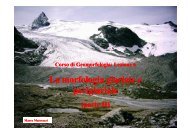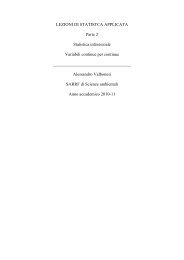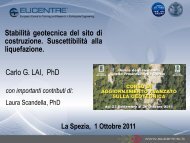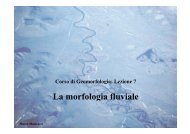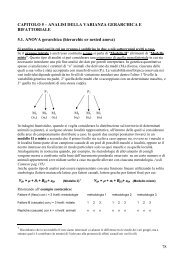La morfologia glaciale Parte I (file pdf) - Scuola di Scienze Ambientali
La morfologia glaciale Parte I (file pdf) - Scuola di Scienze Ambientali
La morfologia glaciale Parte I (file pdf) - Scuola di Scienze Ambientali
Create successful ePaper yourself
Turn your PDF publications into a flip-book with our unique Google optimized e-Paper software.
Marco Materazzi<br />
Corso <strong>di</strong> Geo<strong>morfologia</strong>: Lezione 6<br />
<strong>La</strong> <strong>morfologia</strong> <strong>glaciale</strong><br />
(parte I)
Materazzi M. – Corso <strong>di</strong> Geo<strong>morfologia</strong>: Lezione 6 – <strong>La</strong> <strong>morfologia</strong> <strong>glaciale</strong><br />
Mo<strong>di</strong>fied from Press and Siever, 1982
Materazzi M. – Corso <strong>di</strong> Geo<strong>morfologia</strong>: Lezione 6 – <strong>La</strong> <strong>morfologia</strong> <strong>glaciale</strong><br />
• Granular<br />
Snow after one year = firn<br />
• Density of 0.4 - 0.8 gm/cc<br />
Glacier ice = 0.8 0 8 to 0.85 0 85 gm/cc<br />
• Mi Mixture t of f ice, i water, t air, i rockk
Materazzi M. – Corso <strong>di</strong> Geo<strong>morfologia</strong>: Lezione 6 – <strong>La</strong> <strong>morfologia</strong> <strong>glaciale</strong><br />
Firn sample is from<br />
p<br />
Jostedalsbreen glacier (Norway)
Materazzi M. – Corso <strong>di</strong> Geo<strong>morfologia</strong>: Lezione 6 – <strong>La</strong> <strong>morfologia</strong> <strong>glaciale</strong><br />
Firn (from the German) Dense, old snow in which the crystals are partly joined together, but in which<br />
the air pockets still communicate with each other. It has a sugary texture.<br />
Prominent layering in the firn is visible in the wall of a large crevasse on<br />
Weissmiesgletscher, Switzerland.
Materazzi M. – Corso <strong>di</strong> Geo<strong>morfologia</strong>: Lezione 6 – <strong>La</strong> <strong>morfologia</strong> <strong>glaciale</strong><br />
Due tipi iif fondamentali d li<br />
Ghiacciai a calotta o “inlandsis” Ghiacciai <strong>di</strong> tipo alpino
Materazzi M. – Corso <strong>di</strong> Geo<strong>morfologia</strong>: Lezione 6 – <strong>La</strong> <strong>morfologia</strong> <strong>glaciale</strong><br />
An ice cap is an ice mass that covers less than 50 000 km² of land area (usually covering a highland area). Masses<br />
of ice covering g more than 50 000 km² are termed an ice sheet<br />
The ice system includes slow-moving ice sheets fast flowing ice streams and floating ice shelves that<br />
The ice system includes slow moving ice sheets, fast flowing ice streams, and floating ice shelves that<br />
break apart to make icebergs (mo<strong>di</strong>fied from Alley, 1990).
Materazzi M. – Corso <strong>di</strong> Geo<strong>morfologia</strong>: Lezione 6 – <strong>La</strong> <strong>morfologia</strong> <strong>glaciale</strong><br />
Slice through the East and West Antarctic<br />
ice sheets showing their bases relative to<br />
present p sea level. The East Antarctic Ice<br />
Sheet sits on bedrock close to, or above, sea<br />
level. The base of the West Antarctic Ice<br />
Sheet lies on land below sea level (mo<strong>di</strong>fied<br />
from Bentley, y, 1964). )
Materazzi M. – Corso <strong>di</strong> Geo<strong>morfologia</strong>: Lezione 6 – <strong>La</strong> <strong>morfologia</strong> <strong>glaciale</strong>
Materazzi M. – Corso <strong>di</strong> Geo<strong>morfologia</strong>: Lezione 6 – <strong>La</strong> <strong>morfologia</strong> <strong>glaciale</strong><br />
An ice stream is a region g of an ice sheet that moves significantly g yfaster than the surroun<strong>di</strong>ng gice. Ice streams are a type yp of<br />
glacier. They are significant features of the Antarctic where they account for 10% of the volume of the ice. They are up to<br />
50 km wide, 2 km thick, can stretch for hundreds of kilometres, and account for most of the ice leaving the ice sheet.<br />
The speed of an ice stream can be over 1,000 meters per year, an order of magnitude faster than the surroun<strong>di</strong>ng ice. The<br />
shear forces at the edge g of the ice stream cause deformation and recrystallization y of the ice, , making g it softer, , and<br />
concentrating the deformation in narrow bands or shear margins. Crevasses form, particularly around the shear margins.<br />
Most ice streams have some water at their bases, which lubricates the flow. The type of bedrock also is significant. Soft,<br />
deformable se<strong>di</strong>ments result in faster flow than hard rock<br />
Aerial view of an ice stream in the Tian Shan mountain range, Xinjiang autonomous region, China
Materazzi M. – Corso <strong>di</strong> Geo<strong>morfologia</strong>: Lezione 6 – <strong>La</strong> <strong>morfologia</strong> <strong>glaciale</strong><br />
<strong>La</strong>ndsat image of an ice stream on the Slessor Glacier, Flichner<br />
Ice Shelf, East Antarctica<br />
<strong>La</strong>ndsat 1 MSS image of the Byrd Glacier where it joins<br />
the Ross Ice Shelf, Antarctica (USGS).
Materazzi M. – Corso <strong>di</strong> Geo<strong>morfologia</strong>: Lezione 6 – <strong>La</strong> <strong>morfologia</strong> <strong>glaciale</strong>
Materazzi M. – Corso <strong>di</strong> Geo<strong>morfologia</strong>: Lezione 6 – <strong>La</strong> <strong>morfologia</strong> <strong>glaciale</strong><br />
An ice shelf is a thick, floating platform of ice that forms where a glacier or ice sheet flows down to a coastline and<br />
onto the ocean surface. Ice shelves are found in Antarctica, Greenland and Canada only. The boundary between the<br />
floating ice shelf and the grounded (resting on bedrock) ice that feeds it is called the groun<strong>di</strong>ng line. The thickness<br />
of ice shelves ranges from about 100 to 1000 meters
Materazzi M. – Corso <strong>di</strong> Geo<strong>morfologia</strong>: Lezione 6 – <strong>La</strong> <strong>morfologia</strong> <strong>glaciale</strong>
Materazzi M. – Corso <strong>di</strong> Geo<strong>morfologia</strong>: Lezione 6 – <strong>La</strong> <strong>morfologia</strong> <strong>glaciale</strong><br />
Wilkins ice shelf - Antartide
Materazzi M. – Corso <strong>di</strong> Geo<strong>morfologia</strong>: Lezione 6 – <strong>La</strong> <strong>morfologia</strong> <strong>glaciale</strong>
Materazzi M. – Corso <strong>di</strong> Geo<strong>morfologia</strong>: Lezione 6 – <strong>La</strong> <strong>morfologia</strong> <strong>glaciale</strong>
Materazzi M. – Corso <strong>di</strong> Geo<strong>morfologia</strong>: Lezione 6 – <strong>La</strong> <strong>morfologia</strong> <strong>glaciale</strong>
Materazzi M. – Corso <strong>di</strong> Geo<strong>morfologia</strong>: Lezione 6 – <strong>La</strong> <strong>morfologia</strong> <strong>glaciale</strong>
Materazzi M. – Corso <strong>di</strong> Geo<strong>morfologia</strong>: Lezione 6 – <strong>La</strong> <strong>morfologia</strong> <strong>glaciale</strong>
Materazzi M. – Corso <strong>di</strong> Geo<strong>morfologia</strong>: Lezione 6 – <strong>La</strong> <strong>morfologia</strong> <strong>glaciale</strong><br />
Alpine glaciers, St. Elias Mountains, Kluane National Park, Yukon Territory
Materazzi M. – Corso <strong>di</strong> Geo<strong>morfologia</strong>: Lezione 6 – <strong>La</strong> <strong>morfologia</strong> <strong>glaciale</strong>
Materazzi M. – Corso <strong>di</strong> Geo<strong>morfologia</strong>: Lezione 6 – <strong>La</strong> <strong>morfologia</strong> <strong>glaciale</strong><br />
Ghiacciaio dei Forni (Gruppo Ortles-Cevedale)<br />
Ortles Cevedale)
Materazzi M. – Corso <strong>di</strong> Geo<strong>morfologia</strong>: Lezione 6 – <strong>La</strong> <strong>morfologia</strong> <strong>glaciale</strong><br />
Source: Marcus, 1969 (mo<strong>di</strong>ficato)
Materazzi M. – Corso <strong>di</strong> Geo<strong>morfologia</strong>: Lezione 6 – <strong>La</strong> <strong>morfologia</strong> <strong>glaciale</strong>
Materazzi M. – Corso <strong>di</strong> Geo<strong>morfologia</strong>: Lezione 6 – <strong>La</strong> <strong>morfologia</strong> <strong>glaciale</strong>
Materazzi M. – Corso <strong>di</strong> Geo<strong>morfologia</strong>: Lezione 6 – <strong>La</strong> <strong>morfologia</strong> <strong>glaciale</strong>
Materazzi M. – Corso <strong>di</strong> Geo<strong>morfologia</strong>: Lezione 6 – <strong>La</strong> <strong>morfologia</strong> <strong>glaciale</strong><br />
Morfologie tipiche: seracchi o “crevasse”
Materazzi M. – Corso <strong>di</strong> Geo<strong>morfologia</strong>: Lezione 6 – <strong>La</strong> <strong>morfologia</strong> <strong>glaciale</strong><br />
Crepacci nel Ghiacciaio del Madaccio
Materazzi M. – Corso <strong>di</strong> Geo<strong>morfologia</strong>: Lezione 6 – <strong>La</strong> <strong>morfologia</strong> <strong>glaciale</strong><br />
Transverse tension crevasses in the Vedretta della Forcola (Ortles-Cevedale Group) (photo by A. Carton, 1989).
Materazzi M. – Corso <strong>di</strong> Geo<strong>morfologia</strong>: Lezione 6 – <strong>La</strong> <strong>morfologia</strong> <strong>glaciale</strong>
Materazzi M. – Corso <strong>di</strong> Geo<strong>morfologia</strong>: Lezione 6 – <strong>La</strong> <strong>morfologia</strong> <strong>glaciale</strong>
Materazzi M. – Corso <strong>di</strong> Geo<strong>morfologia</strong>: Lezione 6 – <strong>La</strong> <strong>morfologia</strong> <strong>glaciale</strong>
Materazzi M. – Corso <strong>di</strong> Geo<strong>morfologia</strong>: Lezione 6 – <strong>La</strong> <strong>morfologia</strong> <strong>glaciale</strong>
Materazzi M. – Corso <strong>di</strong> Geo<strong>morfologia</strong>: Lezione 6 – <strong>La</strong> <strong>morfologia</strong> <strong>glaciale</strong>
Materazzi M. – Corso <strong>di</strong> Geo<strong>morfologia</strong>: Lezione 6 – <strong>La</strong> <strong>morfologia</strong> <strong>glaciale</strong><br />
Esempio <strong>di</strong> estrazione <strong>glaciale</strong>
Materazzi M. – Corso <strong>di</strong> Geo<strong>morfologia</strong>: Lezione 6 – <strong>La</strong> <strong>morfologia</strong> <strong>glaciale</strong>
Materazzi M. – Corso <strong>di</strong> Geo<strong>morfologia</strong>: Lezione 6 – <strong>La</strong> <strong>morfologia</strong> <strong>glaciale</strong><br />
Le rocce montonate sono generalmente<br />
arrotondate a o o da esop sopra ae e sul su lato a o rivolto vo oa a<br />
monte, irregolari verso valle e allungati<br />
secondo la <strong>di</strong>rezione <strong>di</strong> movimento del<br />
ghiacciaio. <strong>La</strong> loro formazione è dovuta<br />
alla pressione p esercitata dalla massa<br />
<strong>glaciale</strong> e all’azione <strong>di</strong> potente smeriglio<br />
svolta da notevoli quantità <strong>di</strong> detrito<br />
inglobate al suo interno<br />
Strie glaciali su rocce montonate presso il<br />
Passo del Gavia. (foto M. Santilli, 2001).
Materazzi M. – Corso <strong>di</strong> Geo<strong>morfologia</strong>: Lezione 6 – <strong>La</strong> <strong>morfologia</strong> <strong>glaciale</strong><br />
Plateau de Lys – Gressoney (Valle dd’Aosta) Aosta)
Materazzi M. – Corso <strong>di</strong> Geo<strong>morfologia</strong>: Lezione 6 – <strong>La</strong> <strong>morfologia</strong> <strong>glaciale</strong><br />
Rocce montonate e fenomeni <strong>di</strong> estrazione <strong>glaciale</strong>
Materazzi M. – Corso <strong>di</strong> Geo<strong>morfologia</strong>: Lezione 6 – <strong>La</strong> <strong>morfologia</strong> <strong>glaciale</strong><br />
L’erosione <strong>glaciale</strong> ed in particolare l’approfon<strong>di</strong>mento delle valli glaciali è un fenomeno molto<br />
intenso, circa 10-20 volte maggiore <strong>di</strong> quello delle valli fluviali.
Materazzi M. – Corso <strong>di</strong> Geo<strong>morfologia</strong>: Lezione 6 – <strong>La</strong> <strong>morfologia</strong> <strong>glaciale</strong><br />
Valle <strong>glaciale</strong> – Gressoney (Valle d’Aosta)
Materazzi M. – Corso <strong>di</strong> Geo<strong>morfologia</strong>: Lezione 6 – <strong>La</strong> <strong>morfologia</strong> <strong>glaciale</strong><br />
TTypical i lU U shaped h d glacial l i l valley ll (Canada)<br />
(C d )
Materazzi M. – Corso <strong>di</strong> Geo<strong>morfologia</strong>: Lezione 6 – <strong>La</strong> <strong>morfologia</strong> <strong>glaciale</strong><br />
BBerarde, d a U-shaped U h d valley, ll iin the th Ecrins E i National N ti l Park, P k France<br />
F
Materazzi M. – Corso <strong>di</strong> Geo<strong>morfologia</strong>: Lezione 6 – <strong>La</strong> <strong>morfologia</strong> <strong>glaciale</strong><br />
TTypical i lU U shaped h d glacial l i l valley ll (Manteigas, (M t i Portugal)<br />
P t l)
Materazzi M. – Corso <strong>di</strong> Geo<strong>morfologia</strong>: Lezione 6 – <strong>La</strong> <strong>morfologia</strong> <strong>glaciale</strong>
Materazzi M. – Corso <strong>di</strong> Geo<strong>morfologia</strong>: Lezione 6 – <strong>La</strong> <strong>morfologia</strong> <strong>glaciale</strong><br />
A hanging valley is a tributary valley with the floor at a higher relief than the main channel into which it flows. They<br />
are most commonly associated with U-shaped valleys when a tributary glacier flows into a glacier of larger volume.<br />
The main glacier erodes a deep U-shaped valley with nearly vertical sides while the tributary glacier, with a smaller<br />
volume of ice, makes a shallower U-shaped valley. Since the surfaces of the glaciers were originally at the same<br />
elevation, the shallower valley appears to be ‘hanging’ above the main valley. Often, waterfalls form at or near the<br />
outlet of the upper valley
Materazzi M. – Corso <strong>di</strong> Geo<strong>morfologia</strong>: Lezione 6 – <strong>La</strong> <strong>morfologia</strong> <strong>glaciale</strong>
Materazzi M. – Corso <strong>di</strong> Geo<strong>morfologia</strong>: Lezione 6 – <strong>La</strong> <strong>morfologia</strong> <strong>glaciale</strong>
Materazzi M. – Corso <strong>di</strong> Geo<strong>morfologia</strong>: Lezione 6 – <strong>La</strong> <strong>morfologia</strong> <strong>glaciale</strong><br />
U-shaped hanging valley - Alaska
Materazzi M. – Corso <strong>di</strong> Geo<strong>morfologia</strong>: Lezione 6 – <strong>La</strong> <strong>morfologia</strong> <strong>glaciale</strong><br />
Esempio <strong>di</strong> valle alle sospesa (Montana – USA)
Materazzi M. – Corso <strong>di</strong> Geo<strong>morfologia</strong>: Lezione 6 – <strong>La</strong> <strong>morfologia</strong> <strong>glaciale</strong><br />
Glacier National Park. Flathead County,<br />
Montana.
Materazzi M. – Corso <strong>di</strong> Geo<strong>morfologia</strong>: Lezione 6 – <strong>La</strong> <strong>morfologia</strong> <strong>glaciale</strong><br />
<strong>La</strong>go <strong>di</strong> Combal (Val Veny)
Materazzi M. – Corso <strong>di</strong> Geo<strong>morfologia</strong>: Lezione 6 – <strong>La</strong> <strong>morfologia</strong> <strong>glaciale</strong><br />
Tschierva glacier with, in the center, P. Bernina (4049m/13281ft) (Switzerland). From this view<br />
you can recognize all the main parts of a glacier: the ridge with the summits, the cirque, a<br />
tributary glacier (which is not tributary anymore), the snow line, an hanging valley with a<br />
plateau, the main valley of the glacier, crevasses, a moraine valley, screes, the ice tongue and a<br />
meltwater stream
Materazzi M. – Corso <strong>di</strong> Geo<strong>morfologia</strong>: Lezione 6 – <strong>La</strong> <strong>morfologia</strong> <strong>glaciale</strong><br />
Glacial environment (Switzerland Alps)
Materazzi M. – Corso <strong>di</strong> Geo<strong>morfologia</strong>: Lezione 6 – <strong>La</strong> <strong>morfologia</strong> <strong>glaciale</strong><br />
Quando un ghiacciaio che si estendeva al <strong>di</strong> sotto dell'attuale dell attuale<br />
livello del mare si veniva a ritirare, il mare riempiva la vallata<br />
incisa dal ghiacciaio, con la tipica valle a forma <strong>di</strong> U. In tal<br />
modo si sono formate delle rientranze della costa connesse<br />
con il mare e talvolta profonde sino a 1300 mm.<br />
<strong>La</strong> morena formata dall'espansione del ghiacciaio viene<br />
lasciata dal suo ritiro all'inizio della vallata e nel caso dei<br />
fior<strong>di</strong> si trova sott'acqua, <strong>di</strong>minuendone la profon<strong>di</strong>tà<br />
all'imbocco all imbocco.<br />
L'acqua sul fondo dei fior<strong>di</strong> ha spesso una salinità molto<br />
bassa, a causa della sua provenienza dai torrenti e dallo<br />
scioglimento delle nevi: questa acqua dolce, più fredda tende<br />
a scendere sul fondo e a non mescolarsi con l'acqua lacqua <strong>di</strong> mare<br />
presente in superficie.<br />
I fior<strong>di</strong> per la loro stretta imboccatura e per la protezione<br />
offerta dalle elevazioni che li circondano sono eccellenti porti<br />
naturali e vengono utilizzati per le flotte <strong>di</strong> pescherecci e per<br />
attività come l'allevamento ittico e i cantieri navali
Materazzi M. – Corso <strong>di</strong> Geo<strong>morfologia</strong>: Lezione 6 – <strong>La</strong> <strong>morfologia</strong> <strong>glaciale</strong><br />
SSognefjorden fj d (Norway) (N )<br />
Southern Alaska
Materazzi M. – Corso <strong>di</strong> Geo<strong>morfologia</strong>: Lezione 6 – <strong>La</strong> <strong>morfologia</strong> <strong>glaciale</strong><br />
Fjords - Greenland



